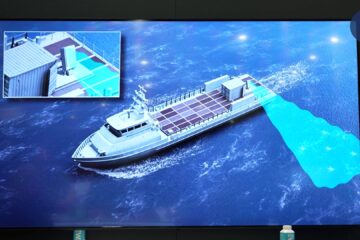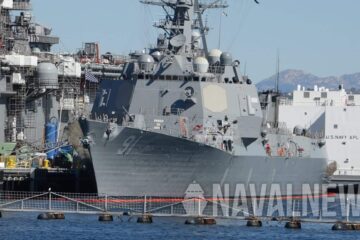Naval News asked the U.S. Navy at Sea Air Space 2021’s virtual prequel and Admiral Jonathan Greenert, 30th Chief of Naval Operations, replied.
Admiral Greenert said on July 20, 2021, “The simple answer is,`Yes, there is a plan to take what has now evolved to the MQ-25A “Stingray”…it is in the budget to be produced as a tanker [by] 2023.’
“The whole concept is, let’s get it going; let’s get it operating from a carrier, get the hard part over: Control of it, integrate it into the air wing, take it from the hangar up to the deck, off to the [refueling] mission, come back, [and] rotate it through. Then what we want to do is figure out what payloads go on there and what missions they can portend. How can we extend the range of this thing? What can we do with it? Can we use it for strike missions? Certainly, we can use it for ISR [Intelligence, Surveillance, Reconnaissance]. The CNO [Chief of Naval Operations, Admiral Michael M.Gilday] wants to get that as soon as possible. If you want years, I’d say three years from IOC [Initial Operating Capability] of a tanker. In his mind [CNO’s], he wants to see this thing doing multiple missions in extending the eyes and ears of the Strike Group, and then you get to the point where it’s unmanned—you’re still controlling it—it’s autonomous, and is it reasonable and needed to integrate strike into it?”
Admiral Jonathan Greenert, 30th Chief of Naval Operations
Naval News Comments

For speculative analysis discussion purposes, the U.S. Navy made no mention as to the UCAV manufacturer and designation to acquire, such as the Boeing X-45, Boeing MQ-25A “Stingray,” Boeing “Phantom Ray,” Northrop Grumman X-47B, and the Kratos XQ-58A “Valkyrie” UCAV prototype designs that have been test-flown even though the MQ-25A has been selected as an unarmed UAV tanker.
Range, speed, stealth, payload, autonomy, combat power, deterrence, and other important factors will determine the type, model, and manufacturer of the U.S. Navy’s UCAV during the acquisition process. The U.S. Navy has yet to fully discuss and expand on the premise of how a fielded UCAV can alter, modernize, and transform the naval fleet with new ships, capabilities, benefits, programs, and tactics and strategies, such as the proposed Drone Carrier Warship concept and Distributed Maritime Operations, Distributed Lethality, Project Overmatch, and Joint All-Domain Command and Control (JADC2).

While the notion of a UCAV is still premature for 2021 (the MQ-25A unmanned tanker comes first), perhaps in the following years, the U.S. Navy will solidify their plans as to how an in-service UCAV can aid in future fleet tactics, strategies, and air wing composition.







